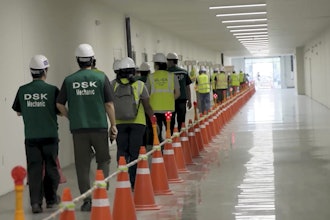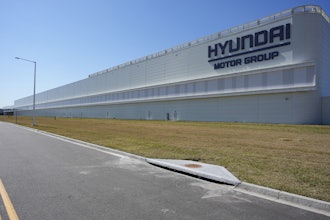This article first appeared in IMPO's June 2013 issue.
The U.S. manufacturing sector is strong, with great potential for future growth, according to the nation’s top industry analysts and economists. The Institute of Supply Management’s (ISM) Purchasing Managers’ Index has held steady above 50 since last November, indicating expansion within the manufacturing economy. U.S. manufacturing technology orders are up, reports The Association For Manufacturing Technology (AMT). And PwC US reports that the majority of U.S. industrial manufacturers remain positive regarding the outlook for the U.S. economy in the year ahead.
“Things are going pretty well,” says Bradley J. Holcomb, CPSM, CPSD, chair of the Institute for Supply Management Business Survey Committee. “Our employment index has been positive for some 44 months. And what that says is that our manufacturers fill vacant jobs and they fill critical jobs. Even though current orders are low, they can see orders coming down the line for some months to come. And this is in anticipation of new business, new orders, and showing the confidence that manufacturing has by keeping employment high.”
Driving The Economy
U.S. manufacturing lost over 2 million jobs between December 2007 and December 2009 — 17 percent of its workforce. While the U.S. hasn’t yet regained all of those jobs lost from the sector, about 12 million Americans are employed in manufacturing today. “Since the recession, manufacturing has been the driver for recovery and continuous economic growth,” says Douglas K. Woods, AMT president.
“While the overall U.S. recovery continues to be slow, manufacturing has experienced stronger growth than many other sectors,” adds Bob McCutcheon, U.S. industrial products leader for PwC. While this is partly due to the steep decline the manufacturing sector experienced during the recession, its strong growth can also be attributed to a “fundamental shift” in the overall competitive landscape for domestic manufacturing. “Energy costs and shifts in supply chain dynamics have created a more favorable environment to manufacturers in the U.S.,” explains McCutcheon. “Those that are more energy intensive, less influenced by labor cost, and more expensive to transport,” are the sectors that will continue to fare the best, he predicts. Shorter lead teams are requiring manufactures to move production closer to American consumers, with the added benefit of reduced inventory costs as well.
The automotive, aerospace, energy, and housing sectors continue to lead manufacturing, with auto topping the list. Consumers returned to the market in 2013 — consumers who had held off on auto purchases during the economic downturn. Now, auto manufacturers are thriving on the growing demand. Additionally, says Woods, “there have been major design and material changes for autos that will demand innovation and growth.”
In addition to the growth for auto manufacturers, shale gas is bringing about what some have called, a ‘new industrial revolution.’ Between lower overall energy costs in the form of natural gas, or the abundant and affordable feed stock from liquids that are benefitting a broad range of chemicals products, says McCutcheon, “we believe manufacturers could save as much as $11 billion annually and create one million jobs by 2025.”
Future Manufacturing
“Today’s manufacturing industry is more sophisticated and high-tech than ever before,” says Woods. “The stereotype of a low-skilled assembly line job simply is not the reality of the current industry.” Today’s manufacturing jobs require critical thinking skills, high-tech specialization (materials science, engineering, advanced computer skills), and an open mind when it comes to a four-year university versus community or technical college programs. “Because the job description has changed significantly, the industry is struggling to recruit a sufficient pool of workers to fit the changing demands of the 21st century manufacturing workplace,” explains Woods.
Building a manufacturing “Smartforce” starts with early public education — STEM education, specifically, Woods adds. “How do we better engage our young people in math and science in a way that resonates with them? It is probably the most important and difficult challenge we face.”
“As an industry, we hold the key to our future workforce,” says Paul Galeski, CEO and founder of MAVERICK Technologies, a manufacturing solutions provider. “Now, more than ever, there is truly an opportunity for a cultural change in how we see the manufacturing industry.” As the baby boomer workforce retires and a new — skilled — generation is given the opportunity of working in a dynamic, global, and high-tech industry, the perception needs to change. Educators, parents, and students need to know “that a community or technical college education, combined with a job in manufacturing, is a great career choice,” says Woods.
“Manufacturing jobs are high paying, high skilled jobs that are proven economic multipliers,” he adds. “They should sell themselves.”
Stresses Galeski, “Without the necessary domestic talent to help U.S. manufacturers transform and compete more efficiently in a global economy, the jobs will go elsewhere.” Increasing the number of formal education programs for students to receive the training they would need to directly pursue careers in manufacturing is one way for the U.S. to put the 300,000-plus available manufacturing jobs today within students’ reach. Apprenticeships and on-the-job training can also develop this necessary talent. Some experts predict the number of unfilled positions in U.S. manufacturing could swell to 5 million by the end of the decade, based on the average age of highly skilled U.S. manufacturing employees today (56) and anticipated unemployment rates. “It is going to take some time to overcome the factors limiting growth,” adds Galeski, “but the future of manufacturing depends on it.”
The number of unemployed and underemployed college graduates, veterans, and other workers available represent an enormous potential asset to the future of manufacturing. Says Woods, “if we don’t make significant strides addressing the skills gap through training and education, we risk losing out on the opportunity to ensure economic security and prosperity for many years to come.”
Buy American
“Manufacturing in the U.S. is solid and robust and something that you can count on and be proud of as one of the principle anchors to the U.S. economy,” says Holcomb. And this is the sentiment that many manufacturers count on when moving operations to America. In addition to cutting currency risks, shortening supply chains, and eliminating considerable shipping costs, ‘Made In The U.S.A.’ comes at a premium in many places across the globe. With a reputation for being made with pride and quality, and providing consumer protection, ‘Made In The U.S.A’ goes beyond a feel good aspect. “Companies want to manufacture in the United States because this is where the ideas are and where the demand is,” says Woods.
Whether it be Toshiba expanding its U.S. presence to meet auto production needs or Airbus opening its first U.S.-based production facility in Alabama, reshoring is real, and creating American jobs. “But without the infrastructure to support this job creation and the skills to support the jobs, this trend cannot be sustained,” explains Woods. “That is where the government comes in.”
Many manufacturers agree that the less the government is involved in their businesses, the better. This is especially the case with larger firms, who aren’t waiting around to see what the government will or will not do on the budget or regulations before taking advantage of opportunities, explains Woods. But he stresses “when our government leaders fail to do the job they were elected to do, it affects business confidence in the future. That means less R&D and job creation.
“But, overall, manufacturers have proven they are not dependent on the government for their success.”
Despite everything in play when it comes to a U.S. manufacturing resurgence and employment, manufacturing is returning to the U.S. — slowly and steadily. Says Holcomb, “manufacturing in the United States is, collectively, a well-run industry — very strong, very durable, very robust in the face of this extended recovery.
“It continues to show that it is an anchor for the U.S. economy.”























